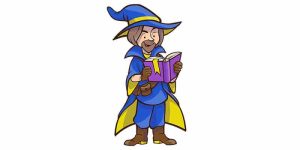Build a forest gnome wizard in Dungeons and Dragons that relies on elemental magic from the School of Evocation and cunning. For example:
Duality is fun. Sometimes, seemingly opposing forces can come together and make something unique on multiple levels. A paladin can turn his back on his oath and become a force for evil, a bard could live a second life as an assassin, and gnomes can hold devastating power in the palms of their little hands.
For this character build, I’m inspired by the idea of Willow Ufgood, the main character from the 1988 fantasy film, Willow. In the movie, Willow is an unassuming farmer with some talent in magic. During the film, his dream is to become a powerful wizard, and that is exactly how I’m going to build him.
(Technically, his dream is to become more of a druid, but just go with me here.)
Because I’m leaning in heavy on the wizard trope, I want to boost Willow with proficiencies in Investigation and Arcana. He’s going to be a wizard’s wizard—the most wizardly wizard. If he doesn’t know something off the cuff, he’ll figure it out with investigation.
Before we jump in, feel free to check out my original adventure, Dead Man’s Tale, and give your wizard a try in a pirate setting. Click here or below for more info.
Forest gnome traits.
Gnomes have a strong racial bonus to Intelligence, making them one of the most suitable candidates for the wizard class in the basic Player’s Guide. Not only does the intelligence score affect the potency of a wizard’s magic, it affects in-game problem solving. All History, Religion, Arcana, Nature and Investigation checks will be based off this score, making the wizard a key resource in solving story challenges.
As most fey races, gnomes come equipped with Darkvision. I mean, when doesn’t that come in handy?
Gnome Cunning grants my little guy advantage on saving throws against magic (Intelligence, Wisdom and Charisma). This race is prebuilt to defend against magic, making the wizard class even more fitting. Gnomes are natural mage duelists.
Choose forest gnome
The forest gnome suits my needs as a player more than the rock gnome. Perhaps if I were playing more of an urban campaign, or something steampunk, the rock gnome would make sense with its tinkering.
However, I’m an adventurer, a dungeon crawler, a treasure hunter. I need something with more field pizzazz.
Forest gnomes receive a +1 bonus to Dexterity, which seems relevant in an adventure. I’m small, I don’t need to worry as much about hit points and bulk armor as much as evasion. For this reason, Willow is going to be a trickster. Let the big, bad warriors engage the enemy while I invoke chaos (structured, wizardly chaos).
They also gain a bonus cantrip, Minor Illusion. As I mentioned, I’ll be playing Willow as a trickster, and this cantrip is a perfect fit—he began the movie as an illusionist, a magician. This spell allows me to create small distractions. The victim will see a small animal or object or hear a sound that isn’t there. It’s easy to get caught up in spells that go boom, and I’ll have plenty of those, but this bonus cantrip will allow me to be creative during gameplay.
Is it overkill for a wizard to gain an extra cantrip? Maybe. We are, however, building a high-octane wizard. So, bring on the free spells.
The other helpful ability forest gnomes receive is Speak with Small Beasts. Straight out of the ranger’s playbook, this ability allows me to communicate with small animals using gestures and sounds. Hilarious. Forest gnomes are also known for carrying small pets, which you can bet I’ll use.
I’m thinking a flying squirrel would be a great fit.
Related Posts:
DnD 5e Guide to Building a Wizard School of Illusion
| DnD 5e: Guide to Building a Bladesinging Wizard
|
Vary spell choices for different purposes
For the wizard class, spell choice is crucial. The wizard is a thinker, a scholar, so naturally, we have many options to choose from. Starting at level 1, I’m allotted 3 cantrips (or spells I can use continually).
Because I chose the forest gnome race, I’m already rolling with the minor illusion spell, so this means Willow is running around with 4 cantrips. So, what about the other three?
I’ll choose Fire Bolt, Ray of Frost and Mage Hand.
Fire Bolt is exactly what it sounds like, a blast of fire that hits for 1d10 fire damage. If there’s something flammable in the way? Even better. This spell packs a wallop and can have devastating secondary effects (igniting stuff). Heavy duty firepower such as the spell should fit well with my small stature, and the ability to create fire has more than one purpose in a game.
Ray of Frost shoots a blue-white beam of frigid magic. On hit, the opponent takes 1d8 cold damage, with his speed reduced by 10 feet until my next turn. The damage is slightly less than the fire option, but speed reduction could add a tactical advantage in a combat situation. Plus, I get to add both ends of the fire/ice spectrum to my on-call arsenal.
Mage Hand offers another creative option to my cantrip list. A spectral, floating hand appears within walking distance. Though the hand can’t attack, activate magic items, or carry more than 10 pounds, it’s hand for trickery or sketchy situations. Want to open a treasure chest that may be booby-trapped? This is your answer.
1st Level Spells
Oh boy, do we have a list of spells to cover.
The wizards spellbook allows me to carry up to 6 1st-level spells. However, I’m only going to have so many a day I’m able to use, so let’s pick out a solid variety.
Detect Magic is first and foremost for me. I’ll be able to detect where magic is coming from, if a magic aura is emanating off a person or object, and from what school the magic comes. This one’s a keeper, for so many reasons. Navigation, magic booby traps, mysterious strangers and investigation all benefit from this spell.
There are limits to this detection. If the magic is behind too much stone, metal, lead or dirt, the detection spell is blocked.
Shield is the next spell on my 1st-level list. I’ve read way too many Harry Dresden novels to not take magical defense seriously. This is my AC when I need it most, a forcefield I can summon to protect myself. Shield grants +5 bonus to AC. Plus, i get to block magic missile.
Comprehend Languages has a lot more to offer than it may seem. Stick with me, we already have boom-boom spells. I need to make sure I have versatile abilities. Comprehend Languages allows me to understand both spoken and written languages, but not necessarily specific secret messages or glyphs. I’ll only use a handful of spells during combat at most, so filling my spellbook with story essentials will help me solve more mysteries.
Now, it’s time to blast away…
Thunder Wave is a molly-whopper. Within a close radius, I erupt with a wave of force, making those around me roll a Constitution save. On a failed save, the creature takes 2d8 thunder damage and is pushed 10 feet away. With a successful save, the creature still takes 1d8 damage, which isn’t bad for a free hit. On top of the creature being pushed, objects within the vicinity are pushed as well.
This spell in particular fits well with a small wizard. If I’m able to launch enemies off me, I won’t have to worry about falling into a close-up combat situation. Field control is important. Also, when I place it level 2+ spell slots, it deals 1d8 more damage per level.
Witch Bolt is gnarly. A blue beam connects the enemy to my focus, and a lightning bolt strikes them continuously until they find cover or move out of range. The damage is 1d12 lightning damage for each turn they’re within range. Kakow! This is some heavy-duty damage dealing, thus the fancy language/detect spells from before.
Magic Missile will round up this list with a varied targeting system. I create 3 missiles to use at my leisure, dealing small but steady amounts of damage. If I want, these missiles can attack the same enemy, essentially giving me a d12 damage roll with the lowest possible score of 3. Or, I can choose to blast several different enemies—maybe a straggler who needs a few health points taken out and a friend.
Level 2 spells.
I could go on and on about spells, so I’ll keep this list brief. There are a couple of awesome choices here, so it’s worth mentioning.
Misty Step will be crucial for escaping tight a tight spot. I had to mention this spell, it’s way cool for a gnome. With a silvery haze surrounding me, I teleport up to 30 feet and land in an empty space (I guess I can’t drop in on someone’s head. Maybe on the second action.) If I’m feeling frisky, I can teleport one turn and drop an elemental nuke on the next.
Flaming Sphere generates a ball of fire that can be moved around the field. For a handful of turns, a 5-foot diameter fireball appears on the battlefield. Any creature that ends its turn within 5 feet of the orb must make a Dexterity saving throw. On a failed save, the creature takes 2d6 fire damage. Now, I can move the flaming orb around the field and target new opponents.
Choose School of Evocation
The School of Evocation is all about elemental magic. Basically, this means I’m a blasty boom-boom mage that focuses on effects like fire and ice, lighting and wind. I’m such a little guy, this much firepower brings me joy.
My Sculpt Spells ability will allow me to create pockets of safety within the effects of my evocation spells. In other words, when I cast my Flaming Sphere, I can choose a number of creatures equal to 1+ the spell’s level. These chosen creature (allies and possibly pets) will automatically succeed on saving throws against the spell. Therefore, I can sling the big, burning ball into a cluster of enemies on a friend and spare the friend.
This will be handy for my Thunderwave spell as well, effectively pushing enemies off a close ally.
Later on, at 6th level, I’ll learn Potent Cantrip and be able to hit creatures with my damage-dealing cantrips even if they complete a saving throw. They’ll take half the damage, but it’s something worthwhile.
To sum it up…
My little forest gnome is ready to bring the thunder. Equipped with devastating elemental magic, knowledge-based short cuts to aid in story developments, and a mischievous flying squirrel, my gnomish wizard should play out to be quite a character.
Related Posts:
DnD 5e Guide to Building a Warlock Genie Patron
| DnD 5e: Guide to Building a Druid Circle of Stars
|
Disclaimer:
Genre Bomb is unofficial Fan Content permitted under the Fan Content Policy. Not approved/endorsed by Wizards. Portions of the materials used are property of Wizards of the Coast. ©Wizards of the Coast LLC.







“I’ve read way too many Harry Dresden novels to not take magical defense seriously.”
This. 100% this!
Did you cry like a baby at ‘Changes’?
Oh yes, Changes wrecked my soul a little bit. What a book. Every interaction he has with Maggie gets me in the gut.
Hey, I got a follow up question. Have you played Curse of Strahd?